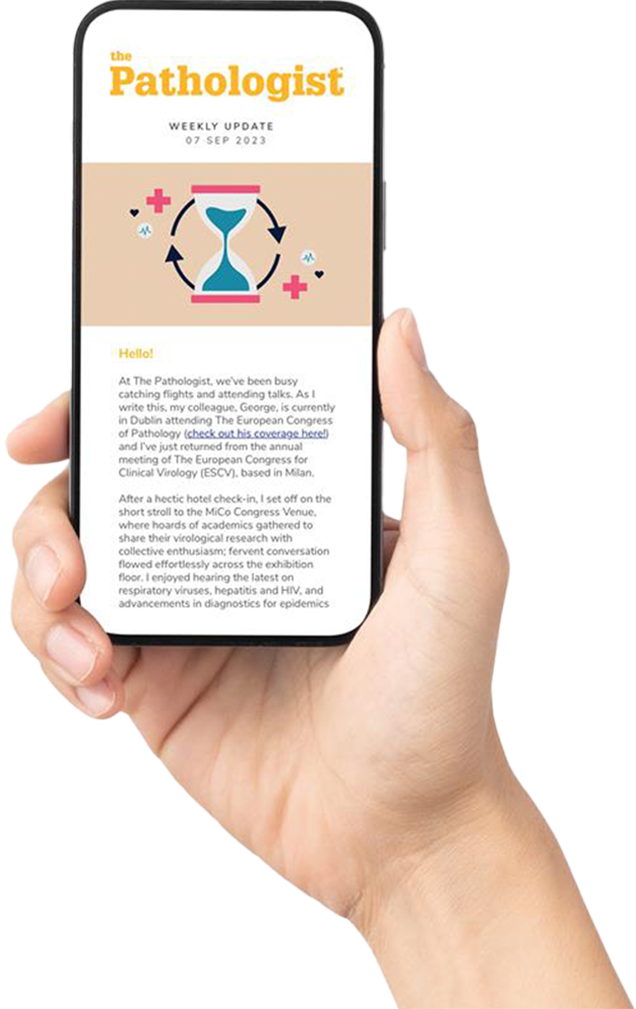
Chris Sleight is Chief Officer at Greater Manchester Diagnostics Network in the UK. With over 30 years’ experience in the National Health Service (NHS), Sleight is renowned for his vast experience in Diagnostics and Pathology. . Following his presentation at the DP&AI Congress in December 2024, we connected with Sleight to discuss why digital technology is so important in recruiting a future workforce.
What are the biggest challenges for laboratory professionals within the NHS?
The biggest challenge we face is workforce shortages, especially in Greater Manchester but this is a national issue for all Networks. While we follow the national NHS England maturity framework to develop our network, we have worked with stakeholders to identify key challenges for Greater Manchester that can be addressed at the network level. Even with two large trusts which it could be argued are networks in their own right – the Northern Care Alliance and Manchester Foundation Trust – workforce issues remain, which need to be tackled at scale.
The NHS as a whole is struggling with shortages of biomedical scientists at all levels, as well as consultants in Pathology across all disciplines. In Greater Manchester, recruitment and retention of biomedical scientists, particularly in cellular pathology, is a significant issue. Cellular pathologists have been recognized as a priority to ensure long-term service stability.
While we have made progress in cellular pathology, workforce concerns persist across the board, affecting all organizations in our network. We also face financial and infrastructure constraints, but the workforce remains our top strategic priority to sustain services for patients and to deliver our ultimate goal to reduce health inequalities for our population – ensuring rapid access to diagnostic services and results to improve patient care.
What does our aging population mean for the pathology field?
Before the pandemic, many pathology professionals stayed in the field for their entire careers and often returned part time in training roles after retirement. This allowed experienced staff to pass on their knowledge while working reduced hours. However, we didn’t fully realize how much we depended on this system.
During and after the pandemic, workforce demographics changed drastically. Normally, the age distribution of pathology professionals formed a balanced curve, peaking around ages 40–45. But around ages 53–55, the number of staff dropped sharply. Many retired professionals who had returned decided to leave permanently, and others opted for early retirement. This trend was seen not just in pathology but across diagnostics, including imaging.
This loss of experience and training capacity had a major impact, and we have yet to fully recover. While we are delighted to have recruited younger high quality histopathologists in Greater Manchester, a significant portion of the workforce is still set to retire in the next five to six years, raising concerns about the future.
At the same time, demand for pathology services is growing due to factors like increased cancer diagnoses, elective care reforms, and an aging population. More people are living longer but are being diagnosed earlier, creating additional strain on the healthcare system. With fewer workers supporting a growing demand for diagnostics – particularly in cellular pathology for cancer diagnostics and faster diagnostic standards – the workforce shortage is becoming even more critical.
Why is digital pathology so important in recruiting a future workforce?
Digital pathology, along with automation, is crucial for recruiting the future workforce for three key reasons:
Firstly, bridging the capacity and demand gap. The growing gap between pathology service capacity and increasing demand requires digital solutions. Digital pathology enables more efficient workflow management, helping to address this challenge.
Secondly, attracting a digital-first generation. Younger generations, particularly Gen Z and Gen Alpha, have grown up with digital technology. They expect seamless digital integration in their professional lives and are less likely to work in environments that rely on outdated tools like traditional microscopes. While older generations may have been sceptical about digital pathology, even perceiving it as a threat to their profession perhaps, younger professionals see it as standard even essential practice.
And thirdly, providing flexibility. Digital pathology allows for remote work and flexible scheduling. Professionals can analyze and report cases from virtually anywhere, removing the need to be physically present in a hospital setting. This level of flexibility is highly attractive to the modern workforce, who prefer to have control over when and where they work.
Digital pathology is not a future innovation – it is already here. Without embracing it now, the field risks failing to attract the next generation of pathologists.
In your talk at the DP&AI Congress, you explained that jobs for generation Alpha don’t exist yet – do you think that the pathology/microbiology field will be able to evolve to fit this generational need?
Pathology and microbiology must evolve to meet the needs of future generations – it’s not optional. Pathology has always changed over time, but we are now at a critical turning point where major transformational shifts are necessary to sustain services. Moving from traditional methods to digital pathology and automation represents one of the biggest changes in decades.
Automation has been present in some areas, such as haematology and biochemistry, for many years, but more recently microbiology and cellular pathology are now undergoing a similar transformation. The demand for pathology services will continue to grow rapidly over the next 40 years, meaning technology must keep advancing to keep pace. The real challenge isn’t whether to change – it’s ensuring that we change quickly enough to avoid falling behind; including time to train our staff in new techniques and processes.
Artificial intelligence (AI) is a key part of this evolution. In industries like banking and retail, AI is already deeply integrated, optimizing operations with minimal waste and maximum efficiency. The NHS, however, maybe for understandable reasons, has been slow to adopt AI, often perceiving it as a futuristic tool rather than a standard necessity. AI has great potential in diagnostics identification and reporting, but also don’t underestimate its real impact in streamlining basic operations – scheduling patients efficiently, ensuring timely sample processing, and delivering faster results.
Despite some lingering scepticism, AI is here to stay. The challenge now is not just accepting AI but implementing it effectively and at the right speed to meet the growing demands of healthcare, and addressing all the challenges that come with this.
Do you think personality types tie into the future generational issue in pathology?
The personality traits of future generations will influence pathology, but the field will continue to attract people – just for different reasons than before. Younger generations, such as Gen Z and Gen Alpha, have grown up in a highly digital world, making them more drawn to technology-driven careers like digital pathology.
Workplace dynamics have also evolved. In the past, there was a strict hierarchy in healthcare, where junior staff had limited interaction with senior professionals. Today, multidisciplinary teams work more collaboratively, which fosters open communication but may also be perceived as a loss of traditional respect for senior roles.
Additionally, generational attitudes toward work schedules have shifted. Younger workers value flexibility and prefer to choose their own hours rather than adhering to rigid schedules. This can sometimes be misunderstood as a lack of professionalism, but in reality, they are just as hardworking – just in a different way.
Every generation views the one before it as outdated and the one after it as unpredictable. The key is adapting to these evolving expectations while maintaining professional standards in the field.
Are there specific initiatives to recruit and retain diverse talent in pathology and laboratory medicine using digital tools?
To attract future generations to careers in pathology and other demanding medical fields, the industry must engage with young people earlier. Career choices are now being made at a younger age, and newer generations also expect to change careers multiple times throughout their working lives. Unlike past generations, their career choices are not limited by geography, and they prioritize flexibility over long-term loyalty to a single employer or profession.
To address this, the industry must:
Engage early. Introducing young students – possibly even in primary school but certainly in high school – to the variety of careers in healthcare beyond doctors and nurses can spark interest before they make critical subject choices. If students are not on a pathway at high school to study key subjects such as sciences and mathematics at A level, they may unintentionally close the door to careers in biomedical science.
Make career entry more flexible. The traditional long and rigid education pathways need to be more adaptable, especially for those with transferable skills. The industry must find ways to train and integrate professionals more efficiently.
Leverage younger role models. Recently qualified professionals, rather than senior figures, should be at the forefront of outreach to future employees. Younger professionals are ideally placed to better connect with students, showing them that these careers are exciting and relevant to their futures.
Use networks for long-term strategy. While individual organizations focus on immediate recruitment and retention, networks can take a broader approach. Events, partnerships with schools, and interactive experiences – such as those we have delivered at the Manchester Science and Industry Museum – can introduce young people to pathology and related fields in an engaging way.
Adapt to changing learning styles. Gen Z and Gen Alpha have grown up with technology and expect interactive, digital learning experiences. They are highly curious, especially Gen Alpha, and need constant engagement. The industry must evolve its approach to appeal to these learning preferences.
By making these changes, pathology and related fields can attract and retain the next generation of professionals, ensuring the workforce keeps up with future demands.
How can laboratory professionals take an active role in driving digital transformation and ensuring its success?
For younger generations, digital transformation isn’t really a “transformation” at all – it’s just the norm. If the pathology field hasn’t fully adopted digital technology by the time Gen Alpha enters the workforce in a few years, they simply won’t be interested in these careers. They expect what we call “cutting-edge, seamless technology” and are easily frustrated by outdated or inefficient systems.
Unlike older generations, who may still hesitate with technology or fear making mistakes, younger generations intuitively understand and trust digital tools. They don’t overthink how technology works – they just use it. This shift means the healthcare system must ensure digital systems are fully integrated, efficient, and reliable.
However, this dependence on technology also creates a risk. Many younger professionals may not know how to function without digital tools. If systems fail, there needs to be robust contingency plans, as fewer people are trained in manual processes. Hospitals already face challenges when digital failures occur, with some doctors and pharmacists never having dealt with hand written paper prescriptions for example.
With Gen Z now making up a larger share of the workforce than Baby Boomers, the healthcare industry must move quickly to ensure its digital infrastructure is resilient. Future professionals won’t adapt to outdated methods – they will expect workplaces to keep pace with technological advancements.




